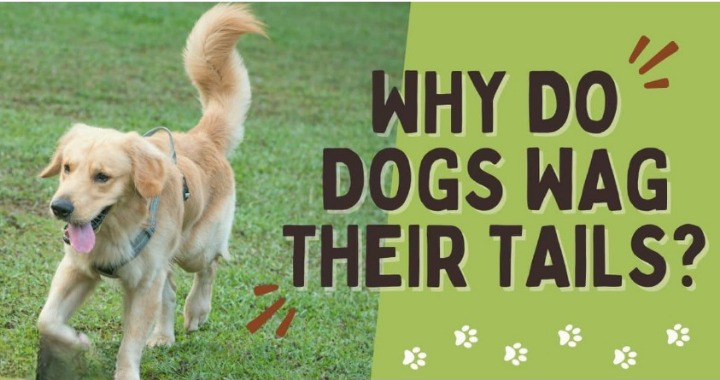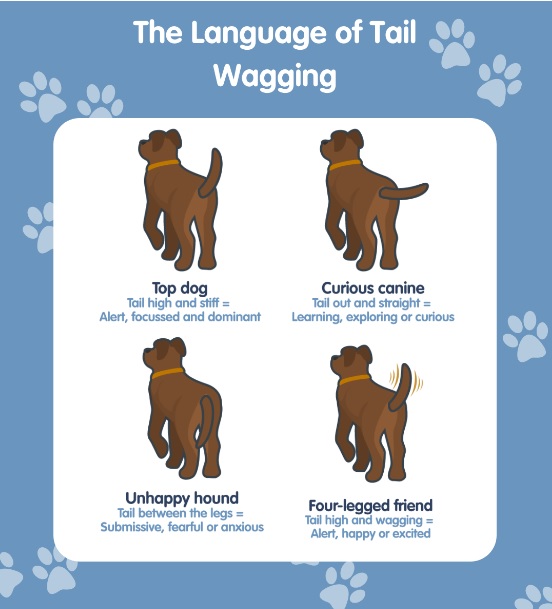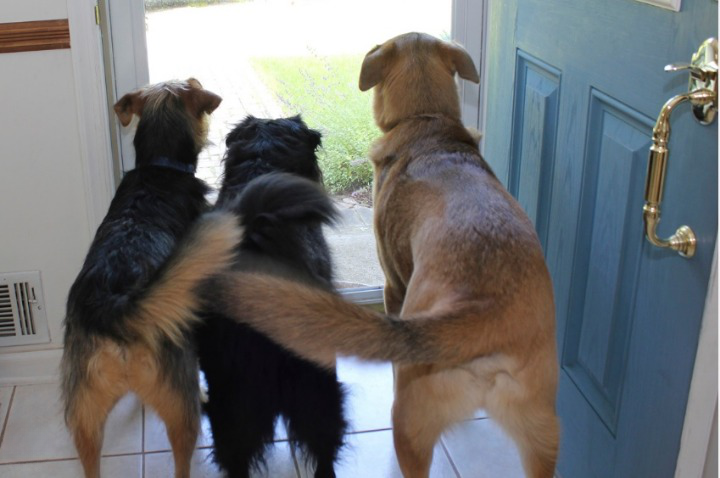In the realm of canine behavior, few gestures are as universally recognized and endearing as a wagging tail. Whether it be slow and gentle or fast and furious, a dog’s wagging tail communicates much more than just happiness. This intriguing phenomenon has captivated scientists and dog lovers alike, prompting the question: why do dogs wag their tails?
Consider the case of Max, a lovable Labrador Retriever. Whenever his owner returns home from work, Max’s tail wags vigorously from side to side, expressing his excitement and joy. But is this the only reason behind his tail-wagging display?

This article delves into the multifaceted nature of dogs’ tail wagging behavior. We explore its anatomy, different types of wagging and their meanings, its role as a communication tool among canines, and how emotions influence tail movement. Additionally, we delve into controversial topics such as tail docking and discuss the importance of understanding tail wagging in training and behavior modification.
By unraveling the intricacies behind dogs’ tail wagging behavior, we aim to provide insights that will not only deepen our connection with our furry friends but also enhance our ability to serve them better.
Key Takeaways
- Tail wagging is a universal gesture in canine behavior that communicates more than just happiness.
- Different types of tail wagging convey different meanings, with 79% of dogs wagging their tails to the right when experiencing positive emotions.
- Tail wagging is a visual means of communication for dogs, and understanding it helps interpret their emotional state.
- The speed, intensity, position, and direction of tail wagging provide important clues about a dog’s emotions and internal experiences.
The Anatomy of Dogs Wag Their Tails
The wagging of a dog’s tail is a complex behavior that involves the coordinated movement of muscles, tendons, and bones in the tail. This behavior serves as a visual communication signal to convey various emotional states.
Dog tail movement is controlled by specific muscles that are attached to the base of the tailbone. When these muscles contract, they cause the tail to move from side to side or up and down. The intensity and speed of the wagging can vary depending on the emotional state of the dog.
Tail wagging behavior is not only limited to expressing happiness or friendliness; it can also indicate fear, anxiety, or aggression. Understanding and interpreting a dog’s tail movements can help humans better understand their needs and emotions, facilitating effective communication between dogs and their owners.
Types of Tail Wagging and Their Meanings
Different patterns of tail movement in canines can convey various messages, with a study revealing that 79% of dogs wag their tails to the right when they are experiencing positive emotions, such as joy or excitement.
However, tail wagging behavior is not limited to just one direction or meaning. Dogs exhibit different types of tail wagging depending on the situation and their individual personalities.

For example, a fast and vigorous wag may indicate high arousal or friendliness, while a slow and tentative wag may suggest uncertainty or fear. Additionally, different dog breeds may have unique tail wagging behaviors. Some breeds have naturally curled tails that may wag differently than those with straight tails.
Understanding these variations in tail wagging can provide valuable insights into a dog’s emotional state and help improve communication between humans and their canine companions.
Dogs Tail Wagging as a Communication Tool
Tail wagging serves as a visual means for canines to effectively communicate their emotional state and establish a connection with humans. It is an essential component of canine socialization and plays a significant role in human-dog communication. Dogs use tail wagging to convey various emotions, such as happiness, excitement, fear, or aggression. Understanding the different types of tail wagging and their meanings can help humans interpret a dog’s emotional state accurately.
To illustrate the significance of tail wagging in communication, we can consider the following table:
| Type of Tail Wag | Meaning |
|---|---|
| High Tail Wag | Indicates happiness or confidence |
| Low Tail Wag | Suggests fear or submission |
| Rapid Tail Wag | Shows excitement or anticipation |
| Slow Tail Wag | Signifies caution or uncertainty |
By observing a dog’s tail wagging behavior along with other nonverbal cues like body posture and facial expressions, humans can better understand dogs’ emotions and respond appropriately. This understanding allows for effective communication between humans and dogs, leading to stronger bonds and improved overall well-being for both parties involved.
The Role of Body Language in Tail Wagging
Body language plays a crucial role in interpreting the subtle nuances of a dog’s emotional state, particularly when it comes to tail wagging. A wagging tail can convey a range of emotions, from happiness and excitement to fear and anxiety. Understanding the role of body language in tail wagging can provide valuable insights into a dog’s behavior and intentions.

- Evolutionary significance: Tail wagging is believed to have evolved as a form of communication between dogs. It serves as a visual signal that conveys important information about their emotional state.
- Cultural differences: Different cultures may interpret tail wagging differently. For example, in some cultures, a high and stiffly wagging tail may indicate aggression or dominance, while in others it may signify friendliness.
- Speed and intensity: The speed and intensity of the tail wag can also provide clues about a dog’s emotional state. A fast, wide wag usually indicates excitement or happiness, while slow wags with tense body posture may suggest caution or fear.
- Position and direction: The position and direction of the tail are also significant. A high-held tail suggests confidence or alertness, while a low-held or tucked-under tail signals submission or fear.
Understanding these aspects of body language can help us better understand our canine companions’ emotions and improve our interactions with them.
Canine Emotions and Tail Wagging
The emotional state of canines can be inferred through the subtle movements and positions of their tails, providing valuable insights into their internal experiences. Canine expressions, such as tail wagging, play a crucial role in social interaction among dogs and with humans.

While tail wagging is commonly associated with happiness or friendliness, it is important to note that this behavior can also convey other emotions such as fear, anxiety, or aggression. The position of the tail, along with its speed and direction of wagging, can further indicate the intensity and specific nature of these emotions.
For example, a high wagging tail accompanied by relaxed body language suggests a positive emotional state, while a low wagging tail held stiffly may indicate potential aggression or unease. Understanding canine emotions through their tail expressions enhances our ability to interpret their needs and establish meaningful connections with them.
The Science Behind Tail Wagging
This discussion will explore the science behind tail wagging in dogs, focusing on three key factors: neurological factors, hormonal influences, and genetic predispositions.
By examining these aspects, we can gain a better understanding of why dogs wag their tails and how different factors contribute to this behavior.
Neurological factors refer to the brain mechanisms involved in tail wagging, while hormonal influences examine the role of hormones in regulating this behavior.
Additionally, genetic predispositions will be explored to understand how certain breeds or individuals may have a higher tendency to wag their tails.
Neurological Factors
Neurological factors contribute to the phenomenon of dogs wagging their tails. This behavior is a result of complex neurological signals within a dog’s brain and spinal cord. The following factors play a significant role in tail wagging behavior:
- Activation of the motor cortex: When a dog is excited or happy, signals from the brain’s motor cortex are sent to the muscles controlling its tail, causing it to wag.
- Neurotransmitters: Chemical messengers called neurotransmitters facilitate communication between neurons involved in tail wagging, such as dopamine and serotonin.
- Tail position: The position of the tail can provide insight into a dog’s emotional state. A relaxed horizontal tail indicates contentment, while an upright or tucked tail may indicate fear or aggression.
- Social cues: Dogs often use their tails to communicate with other dogs and humans, using different speeds and directions of wagging to convey different messages.
- Breed differences: Certain breeds have genetic variations that influence their tail anatomy and wagging patterns.
Understanding these neurological factors helps us better interpret a dog’s emotions and enhance our ability to provide appropriate care and support.
Hormonal Influences
Hormonal influences play a significant role in the intricate behavior of tail movement observed in canines. The endocrine system, responsible for producing and regulating hormones, has been found to impact dogs’ behavioral patterns.

Hormones such as oxytocin and cortisol have been linked to tail wagging in various contexts. Oxytocin, often referred to as the ‘love hormone,’ is released during positive social interactions and promotes affiliative behaviors. When dogs are happy or excited, increased levels of oxytocin can lead to vigorous tail wagging.
On the other hand, cortisol, known as the stress hormone, is released when dogs experience fear or anxiety. High levels of cortisol may cause dogs to exhibit nervous or hesitant tail movements.
Understanding the hormonal influences on canine tail wagging provides valuable insights into their emotional states and can contribute to effective communication between humans and dogs.
Genetic Predispositions
Genetic predispositions play a crucial role in shaping the intricate behavior of tail movement observed in canines, evoking awe and wonder at the remarkable diversity that exists within different breeds. Dogs inherit their tail wagging tendencies through genetic inheritance, which contributes to the wide range of tail movements exhibited across various breeds.
This genetic variation results from evolutionary advantages gained by certain traits over time. For instance, upright tails in some breeds may have evolved to signal dominance or assertiveness, while lower-set tails could indicate submission or submissiveness. Additionally, the speed and vigor of tail wagging can also be influenced by genetic factors.
Understanding these genetic predispositions provides valuable insight into canine behavior and helps us appreciate the complexity and adaptability of our canine companions.
Tail Docking and Its Impact on Tail Wagging
Behavioral studies have shown that tail docking, a procedure in which a dog’s tail is surgically removed, can significantly impact the range and intensity of tail wagging. Tail docking has been a topic of controversy due to its ethical implications. The procedure is often performed for cosmetic purposes or to prevent potential injuries, such as when working dogs are involved in certain activities. However, it has raised concerns among animal welfare organizations and veterinarians who argue that it causes unnecessary pain and compromises the dog’s ability to communicate effectively through tail wagging.
Tail docking can lead to chronic pain and discomfort.
Dogs with docked tails may experience difficulties in conveying emotions accurately.
The procedure may hinder social interactions between dogs by disrupting normal communication signals.
Understanding the impact of tail docking on tail wagging is essential for addressing the ethical concerns associated with this practice and making informed decisions regarding dog welfare.
The Importance of Tail Wagging in Training and Behavior Modification
The significance of tail wagging in training and behavior modification cannot be understated, as it serves as a crucial non-verbal communication tool that can profoundly influence the emotional state and receptiveness of dogs. Tail wagging is a form of body language that conveys various emotions such as happiness, excitement, or anxiety. Understanding and interpreting the different types of tail wags can help trainers and behaviorists gauge a dog’s level of comfort and engagement during training sessions.
Positive reinforcement and reward-based training methods play a vital role in utilizing tail wagging to enhance learning and behavior modification. By associating desired behaviors with rewards such as treats or praise, dogs are motivated to repeat those behaviors. When a dog wags its tail happily after receiving positive reinforcement, it indicates their understanding and willingness to continue working towards desired outcomes.
In order to further demonstrate the importance of tail wagging in training and behavior modification, consider the following table:
| Tail Wag Position | Meaning |
|---|---|
| Wagging high with loose movements | Happiness/Eagerness |
| Rapid side-to-side wag with tucked under tail | Anxiety/Fearfulness |
| Slow side-to-side wag with low-hanging tail | Mild caution/Uneasiness |
By observing these subtle cues, trainers can tailor their approaches accordingly, ensuring effective communication and fostering a positive learning environment for dogs.
Wagging Tail Etiquette: How to Approach a Wagging Dog
Tail wagging serves as an important form of communication in the canine world, and understanding this behavior is crucial for effective interactions with dogs.
However, it is essential to be mindful of appropriate etiquette when approaching a wagging dog. The current subtopic focuses on tail wagging etiquette and provides guidelines for how to approach a dog displaying this behavior.
When encountering a dog with a wagging tail, it is important to assess the overall body language of the animal. A loose and relaxed body posture accompanied by a gentle wag may indicate friendliness and an invitation for interaction. On the other hand, a stiff body posture or high-set tail with rapid wagging can signal anxiety or aggression.
Approaching such dogs should be done cautiously, giving them space and allowing them to approach voluntarily if they feel comfortable. It is advisable to avoid sudden movements or direct eye contact that may escalate their anxiety or provoke defensive behaviors.
By respecting these guidelines, individuals can enhance their understanding of dog behavior and ensure safer interactions by promoting positive communication between humans and our furry companions.
Fun Facts About Tail Wagging
One fascinating aspect of canine communication is the wide range of emotions that can be conveyed through the subtle movements and positions of a dog’s wagging appendage. Tail wagging is not only a form of communication but also serves as an indicator of various underlying factors.
Here are some fun facts about tail wagging:
- Evolutionary origins: The phenomenon of tail wagging can be traced back to the evolutionary history of dogs, where it served as a way for early canines to communicate with each other. Over time, this behavior has become more nuanced and complex.
- Cultural differences: It is interesting to note that different cultures have different interpretations of tail wagging. For example, in some cultures, a high and fast wag may indicate excitement or friendliness, while in others it may signal aggression or fear.
Understanding these fun facts about tail wagging helps us gain insight into the rich world of canine communication and highlights the importance of observing and interpreting a dog’s body language accurately in order to better serve their needs.
SEE ALSO:
- Why Is My Dog Coughing
- Welcome to Mundo de 4 Patas
- Dog Luv Us And We Luv Them
- Why Do Dogs Shake? Causes, Symptoms & Treatments
Frequently Asked Questions
How do dogs communicate without wagging their tails?
Dogs communicate without wagging their tails through a complex system of body language, vocalizations, and facial expressions. Their repertoire includes various postures, barks, growls, whines, and subtle changes in their facial expressions to convey their emotions and intentions effectively.
Can tail wagging be a sign of aggression or fear in dogs?
Tail wagging in dogs can indeed be a sign of aggression or fear. Understanding dog behavior and body language is crucial in interpreting this form of communication, as it can indicate various emotions and intentions in different contexts.
Are there any breeds of dogs that don’t wag their tails?
Different types of tailless dog breeds exist, such as the Australian Stumpy Tail Cattle Dog and the Brazilian Terrier. Tail wagging in dogs serves as a vital form of communication between humans and dogs.
Does the speed or height of a dog’s tail wag indicate anything about their emotions?
The speed or height of a dog’s tail wag can provide insights into their emotional state. Tail wagging is a form of body language that humans use to interpret dog behavior, allowing us to better understand and serve them.
Can dogs still communicate effectively if their tails have been docked?
The tail docking controversy revolves around the practice of removing a dog’s tail, which can impact their socialization and communication abilities. Without a tail, dogs may face difficulties in effectively communicating with other dogs and humans.
Conclusion
Tail wagging is a complex behavior that can be interpreted in a variety of ways. The speed, direction, and position of the wag can all be used to determine a dog’s emotional state. For example, a dog that is wagging its tail quickly and high is likely to be happy or excited, while a dog that is wagging its tail slowly and low is more likely to be feeling submissive or nervous.
Overall, tail wagging is a fascinating behavior that can tell us a lot about how dogs are feeling. By understanding the different ways that dogs wag their tails, we can better understand their communication and build stronger relationships with them.
Help us change lives by supporting Bonevoyagedogrescue. Join our mission to provide love and care to rescued dogs in need. Donate today and make a lasting impact. Read more
